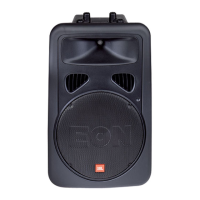19. Bring the channel 1 FADER up to the “0” position.
20. With the performer speaking / singing, slowly bring the MIX L and MIX R faders up until the
desired level is reached. Listen carefully for the onset of feedback and be prepared to bring
the MIX L and MIX R faders down.
21. Set the PAN control to position the sound in the stereo field. With this control centered the
sound will be heard equally in both speakers.
22. Disengage the channel 1 LISTEN switch.
23. Repeat steps 15 thru 22 for all other channels that are in use.
Congratulations – you’ve successfully set-up your system. Now let’s fine tune the mix.
Setting Channel EQ
The term “EQ” is shorthand for Equalization. The tone control on your radio or stereo is a most
basic form of EQ. Sound reinforcement equipment offers more comprehensive control over tonal
balance. Here is a table describing undesired tonal characteristics and how to handle them.
Sound Quality EQ Adjustment
• Too dark, lacks brilliance, seems muddy • Turn up the HF (High Frequency)
• Speech is not clear, vocals don’t project • Increase the MF (Mid Frequency) level
• Rotate the MF frequency control to locate the
desired frequency
• Not enough bass, sound is thin, lacks power • Turn up the LF (Low Frequency)
and authority • Disengage the LOW CUT control
• Sound is brittle, “S” sounds are too hissy, • Turn down the HF
very high-frequency feedback is heard
• Sound is honky or nasal sounding • Turn down the MF EQ
• Rotate the MF frequency control until the sound
quality improves
• Sound is boomy or rumbling, feedback is • Turn down the LF
heard at very low frequencies • Engage the LOW CUT control
• With a lavaliere mic, speech has too much • Turn down the MF LEVEL and set the MF
low mid content frequency control between 300 and 500
Fine Tuning the Mix
Adjust the channel FADERS until the desired blend is achieved.
With the performers speaking or singing, observe the PEAK indicator on the EON15 G2 input panel.
This indicator flashes when the loudspeaker’s on-board amplifiers are approaching maximum out-
put. Occasional flashes are normal for very loud operation. However, if the PEAK LED stays illumi-
nated, the sound may be distorted and it is an indication that more speakers or a lower perform-
ance volume may be required for your specific application.
Doing More With Your System
The Quick Start section of this guide addresses a simple 2-speaker system with microphones only.
This section will explain more advanced uses for your EON System.
Other Sources
In addition to microphones, your EON system will accommodate many sources. Some of these
sources may require special adapters or adapter cables. See the “Connectors” section for more
information.
8

